Named for the author of the Pledge of Allegiance, Francis J. Bellamy, the Bellamy Salute was used from the 1890s until 1942.
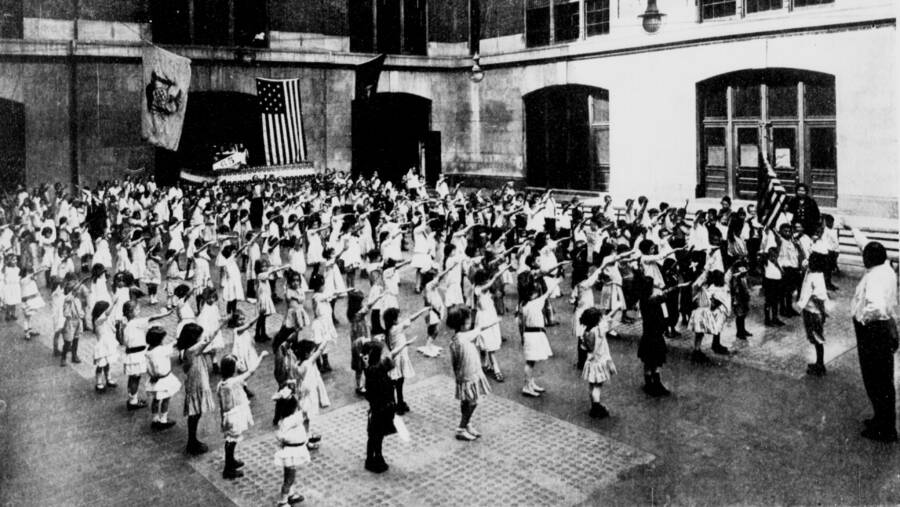
Wikimedia CommonsThe Bellamy Salute, the salute of the U.S. flag until 1942.
The photograph seen above wasn’t taken at an American school that supported the Nazis, though you’d certainly be forgiven for mistaking it as such. Actually, the children in the photo are saluting the American flag with what was known as the “Bellamy Salute” — a hand gesture used by generations of young Americans while pledging allegiance to the flag.
The gesture was named after Francis J. Bellamy, the man who wrote the Pledge of Allegiance. For 50 years, the Bellamy Salute was standard in U.S. schools and obediently performed by school children across the nation.
But as the Nazis began to rise in Europe in the 1930s, many Americans became uncomfortable with the optics of American school children saluting the flag with a Nazi-like gesture. In 1942, Congress amended the Flag Code to get rid of the Bellamy Salute entirely.
This is the surprising story of the rise and fall of the Bellamy Salute.
Francis J. Bellamy Writes The Pledge Of Allegiance
The story of the Bellamy Salute begins with Francis Julius Bellamy, the author of the Pledge of Allegiance. Born on May 18, 1855 in Mount Morris, New York, he spent his young adulthood as a Baptist minister, and later came to work for a magazine called Youth’s Companion.
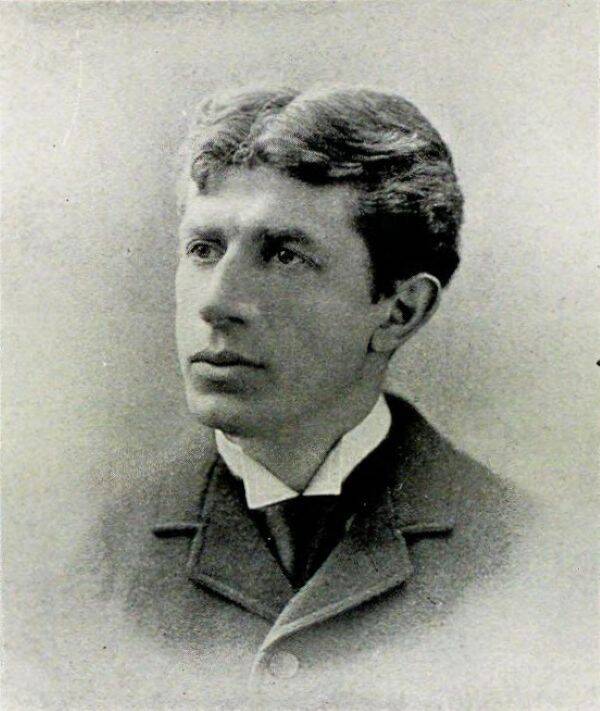
Wikimeda CommonsFrancis J. Bellamy pictured in 1894.
The magazine was run by a man named Daniel Sharp Ford who, in the years following the Civil War, was looking for ways to unify the country. He fully embraced the schoolhouse flag movement, which aimed to put an American flag in every U.S. school as a way to bring people together.
In pursuit of this goal, Ford gave Bellamy an assignment: to write a “pledge” to the flag that Americans could easily recite. Bellamy accepted the assignment, and wrote the Pledge of Allegiance, which originally read:
“I pledge Allegiance to my Flag and to the Republic for which it stands, one Nation indivisible, with Liberty and Justice for all.”
The pledge, meant to coincide with the 400 year anniversary of Christopher Columbus’ arrival in the New World, was published in the Sept. 8, 1892 edition of Youth’s Companion. And on Oct. 12, 1892, an estimated 12 million U.S. school children recited Bellamy’s pledge.
But Ford and Bellamy had not just come up with a pledge. They also came up with a salute, which soon became known as the Bellamy Salute.
The Rise And Fall Of The Bellamy Salute
Alongside the Pledge of Allegiance, Youth’s Companion instructed students on how they should salute the flag while reciting the pledge.
“At a signal from the Principal the pupils, in ordered ranks, hands to the side, face the Flag,” Youth’s Companion stated. “Another signal is given; every pupil gives the flag the military salute — right hand lifted, palm downward, to a line with the forehead and close to it.”
Students were instructed to remain with their hands raised, palm downward, until the line “my Flag,” at which point they were instructed to turn their palms up toward the flag until the pledge was complete.
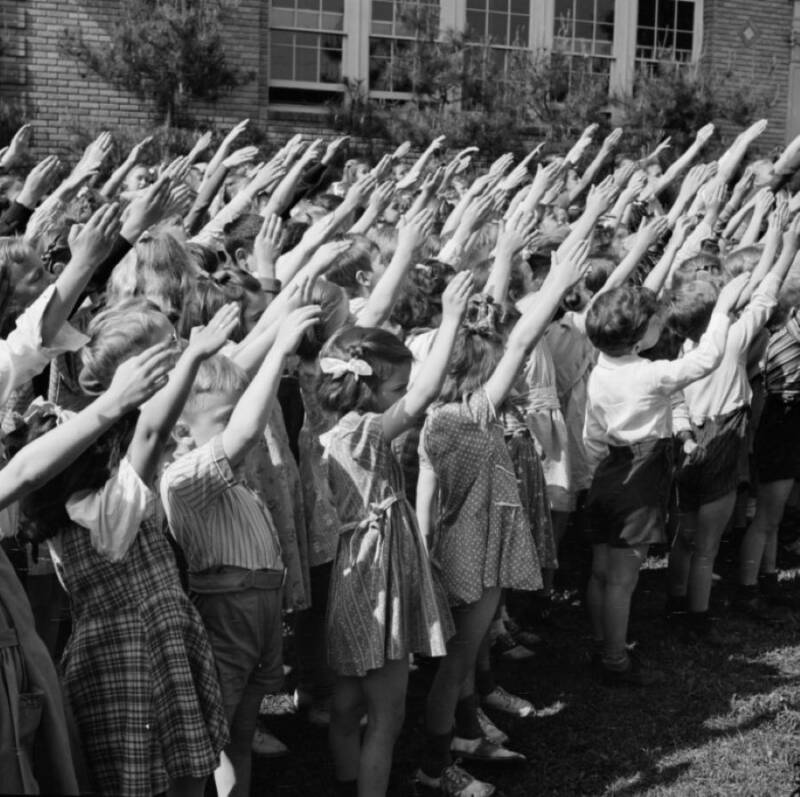
Wikimedia CommonsIn the 20th century, fascists started using a similar salute.
The Pledge of Allegiance, and its accompanying gesture, the Bellamy Salute, became a mainstay of schools across the United States. But just a few decades later, things began to change.
In the early 20th century, fascism began to rise in Europe. In the 1920s, Italian fascists lead by Benito Mussolini adopted what they called the “Roman salute” (though according to History Extra, its origins lay more in 18th-century French art than the Roman Empire itself). A similar salute was soon adopted by Adolf Hitler’s Nazis, who began gaining power in Germany in the 1930s. Both bore a striking similarity to the Bellamy Salute.
Americans began to notice the parallels between their salute and the fascist salute starting in the 1930s, according to To the Flag: The Unlikely History of the Pledge of Allegiance by Richard J. Ellis. What’s more, some worried that photos and videos of the Bellamy Salute could be used as propaganda.
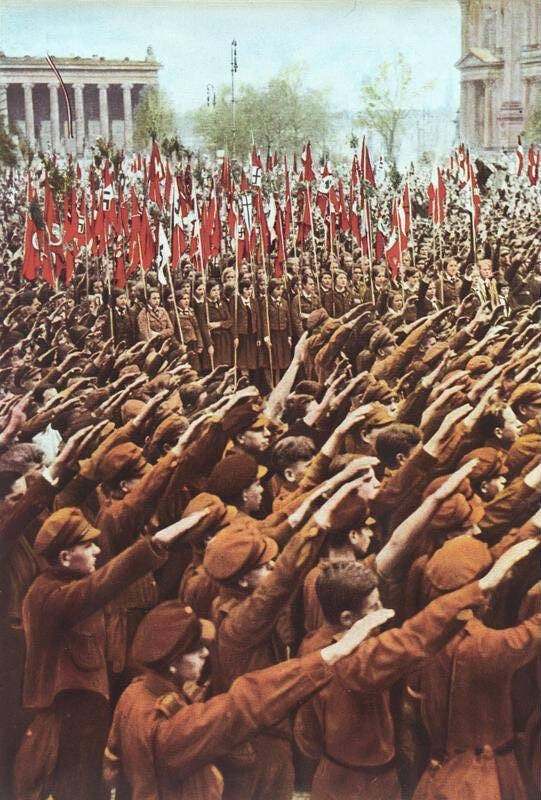
German Federal ArchivesHitler Youth giving the Nazi salute in Berlin. 1933.
Some Americans wanted to change the Bellamy Salute immediately; others argued that they shouldn’t have to change an American gesture, just because Germans and Italians were using a similar one.
But after the beginning of World War II, Congress stepped in.
Congress Amends The U.S. Flag Code In 1942
In June 1942, Congress passed Public Law 77-623, which codified a number of rules about the American flag, including the appropriate gesture during the Pledge of Allegiance.
The pledge, the law explained, should “be rendered by standing with the right hand over the heart; extending the right hand, palm upward, toward the flag at the words ‘to the flag’ and holding this position until the end, when the hand drops to the side.” In other words, it kept the Bellamy Salute intact.
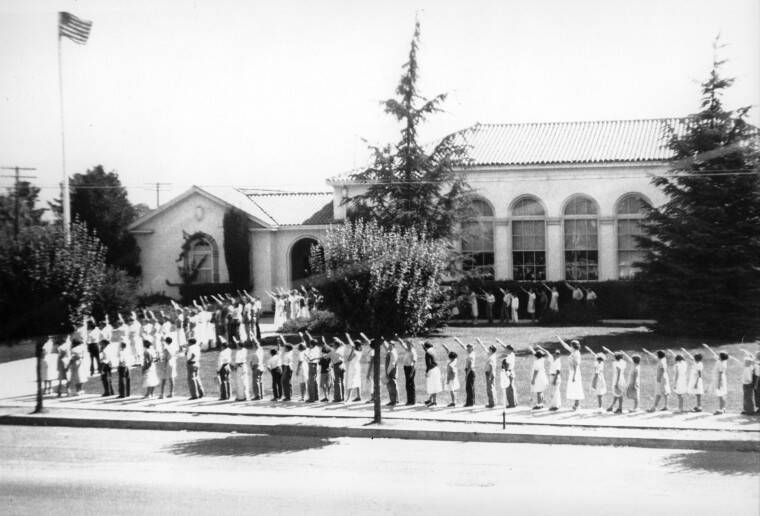
Wikimedia CommonsSchool children reciting the Pledge of Allegiance.
But that December, Congress amended the the U.S. Flag Code and dispensed of the Bellamy Salute entirely. It instructed Americans to recite the Pledge of Allegiance “by standing with the right hand over the heart.”
That said, the removal of the Bellamy Salute is hardly the only way that the Pledge of Allegiance has changed since Francis Bellamy first wrote it in 1892. In the 1920s, the wording of the pledge was slightly changed, from “I pledge allegiance to my flag” to “I pledge allegiance to the flag” (italics added). And in the 1950s, during the Cold War, President Dwight D. Eisenhower oversaw the inclusion of “under God” to the pledge.
Since then, the pledge has remained unchanged: “I pledge allegiance to the flag of the United States of America, and to the republic for which it stands, one nation under God, indivisible, with liberty and justice for all.”
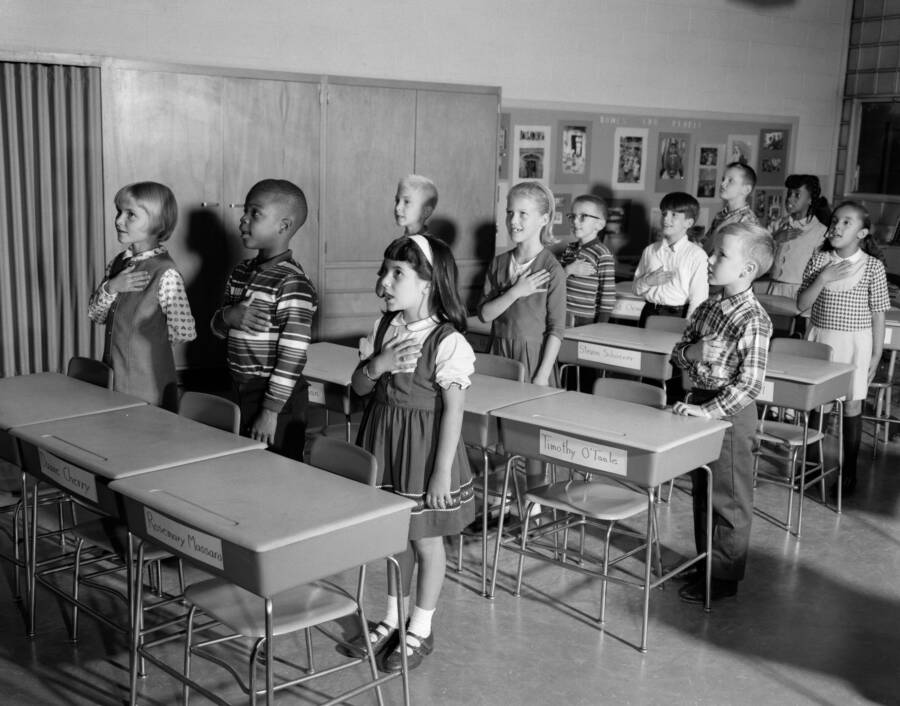
ClassicStockAmerican school children reciting the Pledge of Allegiance, with their hands over their hearts, in the 1960s.
But not everyone is happy about it. In 2002, the granddaughter of Francis Bellamy, Sally Wright, even wrote an op-ed in The New York Times to speak out against the inclusion of “under God” in the Pledge of Allegiance.
“By adding the phrase “under God” to the Pledge of Allegiance in 1954, Congress was attempting to distinguish the politics of the United States from godless Communism,” she wrote. “Like other actions taken by Congress at that time, this change divided our nation further rather than uniting its citizens.”
However, the Pledge of Allegiance has not been amended since the Eisenhower years. Thus, to this day, American children still pledge allegiance to one nation, and no other, under God.
But they’re no longer using the Bellamy Salute as they do so.
After reading about the rise and fall of the Bellamy Salute, go inside the fascinating story of who made the American flag. Then, learn about the flag-raising on Iwo Jima during World War II that became one of the United States’ most iconic images.





